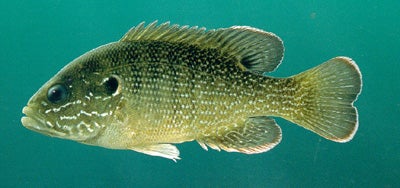SCIENTIFIC NAME: Lepomis cyanellus
CHARACTERISTICS: Green sunfish have 41 to 53 lateral line scales. The dorsal fin usually has 10 (rarely nine or 11) spines and 10 to 12 rays. The anal fin has three spines and eight to 11 rays. Palatine teeth are present in the roof of the mouth. The pectoral fin is short and does not reach the nostril when bent forward. The mouth is large, the upper jaw extending to near the middle of the eye. The ear flap is elongate, black, and usually inflexible to near its margin. Body color is brownish green on the back and sides with rows of small, metallic blue spots toward the head and irregularly spaced spots toward the tail. A large black spot occurs near the rear of the soft dorsal and anal fins. The edges of the pelvic, anal, caudal, and soft dorsal fins are yellow to orange, becoming much brighter during the spawning season.
ADULT SIZE: 4 to 8 in (102 to 203 mm).
STATE RECORD:
a list of the State Record Freshwater Fish.
DISTRIBUTION: The green sunfish is native to the central United States from the Great Lakes south to the Gulf Coast. Its native range has been expanded in the United States and northern Mexico by stocking and sometimes accidental introduction into private ponds and public lakes. Limited habitat and competition with bluegill and redspotted sunfish may partly account for the sparse distribution of green sunfish across south Alabama.
HABITAT AND BIOLOGY: Green sunfishes tolerate a wide range of environmental conditions. They are widespread and often abundant in small to large streams, springs, swamps, and ponds, becoming less abundant in large rivers and reservoirs. Pflieger (1975) notes that the green sunfish is one of the first fish species to reinvade streams that go dry in late summer. Food items include insects, small fishes, and crayfishes. Spawning occurs from May through July, and sound production plays an important role in the spawning act (Gerald, 1971). Green sunfish are considered undesirable in small ponds and lakes because they grow much faster than bluegills and redear sunfish, can outcompete them for food and spawning space, and rarely reach suitable size for table fare. Redmond and Krumkolz (1978) report that four- to six-year-old green sunfish are rarely more than six inches long.
ORIGINAL DESCRIPTION: Rafinesque described the green sunfish in 1819.
ETYMOLOGY:
Lepomis means scaled operculum.
Cyanellus means blue.
The copyrighted information above is from Fishes of Alabama and the Mobile Delta.







